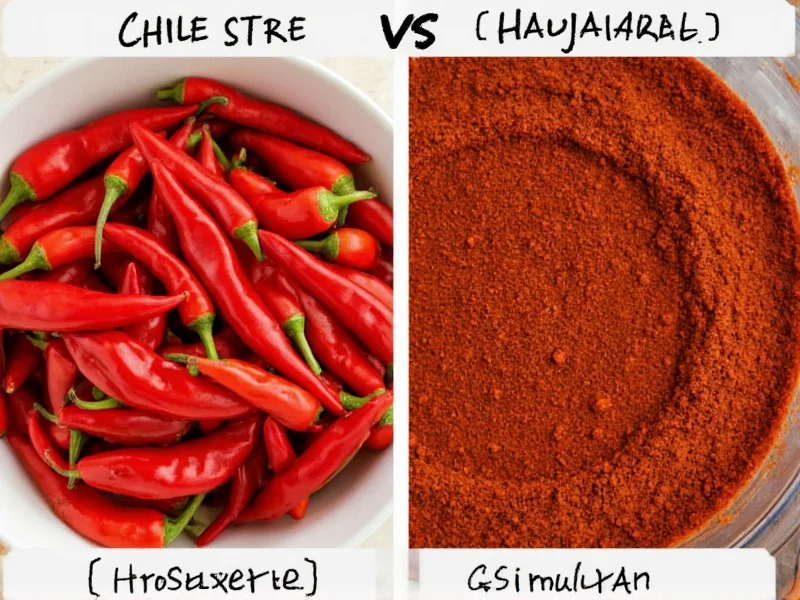Understanding the distinction between chile de ristra and guajillo chiles is essential for authentic Southwestern and Mexican cooking. Many home chefs confuse these terms, leading to disappointing results when recipes call for specific chile varieties. This comprehensive guide clarifies their differences, culinary applications, and proper usage to elevate your cooking with accurate flavor profiles.
What Exactly Is Chile de Ristra?
The term "chile de ristra" translates to "chile string" in Spanish. Ristras are traditional arrangements of dried chiles threaded together and hung to dry. While any chile can technically be made into a ristra, in New Mexico and Southwestern cuisine, ristras most commonly feature New Mexico chiles (also called chile colorado), which are dried Anaheim or Big Jim peppers.
Ristras serve dual purposes: practical preservation and cultural decoration. The drying process concentrates the chile's flavor while extending shelf life. When properly dried and stored, chiles from ristras maintain quality for 6-12 months. The characteristic deep red color of mature New Mexico chiles makes ristras visually striking decorative elements in Southwestern homes.
Understanding Guajillo Chile Characteristics
Guajillo chiles represent a specific variety of dried chile with distinctive qualities. These chiles come from the mirasol pepper (meaning "looks at the sun"), which grows pointing upward on the plant. After harvesting at peak ripeness, they're dried to become the guajillo variety.
Guajillo chiles feature:
- Smooth, reddish-brown skin with a distinctive sheen
- Leathery but pliable texture when properly hydrated
- Flavor profile combining berry notes with tangy acidity
- Mild to medium heat level (2,500-5,000 Scoville units)
- Approximately 3-6 inches in length with a teardrop shape
Chefs prize guajillos for their complex flavor that adds depth to sauces without overwhelming heat. They're essential in traditional Mexican dishes like mole rojo, adobos, and salsas.
Key Differences Between Chile de Ristra and Guajillo
The most critical distinction is that chile de ristra describes a preservation method, while guajillo identifies a specific chile variety. This fundamental difference explains why substitution between them rarely works well in recipes.
| Characteristic | Chile de Ristra (New Mexico) | Guajillo Chile |
|---|---|---|
| Primary Identity | Drying method/presentation | Specific chile variety |
| Base Pepper | New Mexico chile (dried Anaheim) | Mirasol pepper |
| Heat Level | Mild (500-2,500 SHU) | Mild-Medium (2,500-5,000 SHU) |
| Flavor Profile | Earthy, slightly sweet, grassy notes | Tangy, berry-like, subtle tea notes |
| Texture When Rehydrated | Firm with noticeable skin | Smooth, almost paste-like |
| Common Culinary Uses | Green chile stew, red chile sauce | Mole rojo, adobo marinades, salsas |
| Regional Association | New Mexico, Southwest USA | Mexico (particularly Central regions) |
Culinary Applications and Substitution Guidance
When following authentic recipes, understanding which chile to use prevents flavor imbalances. Traditional New Mexican red chile sauce relies on chiles from ristras (New Mexico chiles), while Mexican mole rojo requires guajillos for proper flavor development.
If substituting becomes necessary:
- Guajillo for ristra chiles: Works acceptably in sauces where tanginess complements other ingredients, but expect brighter acidity
- Ristra chiles (New Mexico) for guajillo: Creates milder, earthier results; add 1/4 teaspoon vinegar per chile to approximate guajillo's tang
- Better alternatives: Ancho chiles provide similar mild heat to New Mexico chiles; cascabels offer comparable earthiness to guajillos
Professional chefs recommend never substituting these chiles in traditional dishes where authenticity matters. The unique flavor compounds in each contribute to regional culinary identities that substitution diminishes.
Common Misconceptions Clarified
Many cooks mistakenly believe "chile de ristra" refers to a specific chile variety. In reality, ristras can contain various chiles including:
- New Mexico chiles (most common)
- Cayenne peppers
- Serrano peppers
- Even ornamental chiles
The term describes the stringing method, not the chile type. When recipes specify "chile de ristra," they typically mean New Mexico chiles prepared in this traditional manner.
Another frequent error involves confusing guajillo with similar-looking chiles like ancho or pasilla. Guajillos have a distinctive smooth skin and characteristic sheen that sets them apart from the wrinkled ancho or dark pasilla varieties.
Selection and Storage Best Practices
When purchasing dried chiles for cooking:
- Look for deep, uniform color without dark spots or mold
- Choose pliable chiles that don't crumble when bent
- Avoid chiles with excessive dust or chemical smells
- Store in airtight containers away from light and moisture
Properly stored, dried chiles maintain optimal flavor for 6-12 months. For extended storage, freeze chiles in vacuum-sealed bags for up to 18 months. Always toast dried chiles lightly before rehydrating to enhance flavor complexity—a crucial step many home cooks skip when working with either New Mexico chiles from ristras or guajillos.
Traditional Preparation Methods
Both chile types require proper preparation to unlock their full flavor potential:
For New Mexico chiles (from ristras):
- Remove stems and seeds
- Dry toast in skillet until fragrant (30-60 seconds per side)
- Soak in hot water for 15-20 minutes until pliable
- Blend with garlic, cumin, and broth for authentic red chile sauce
For guajillo chiles:
- Remove stems and most seeds (retain some for heat)
- Dry toast until aroma intensifies but avoid burning
- Soak in hot water with 1/4 teaspoon vinegar for 20 minutes
- Blend with cloves, cinnamon, and tomatoes for traditional mole
These preparation techniques highlight each chile's unique characteristics while minimizing bitterness. The vinegar addition during guajillo soaking mimics the natural acidity that develops during traditional sun-drying processes in Mexico.











 浙公网安备
33010002000092号
浙公网安备
33010002000092号 浙B2-20120091-4
浙B2-20120091-4